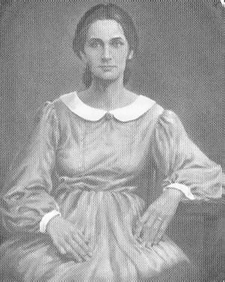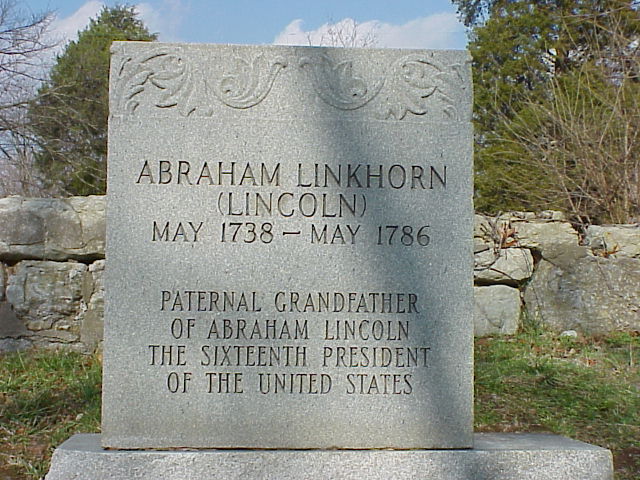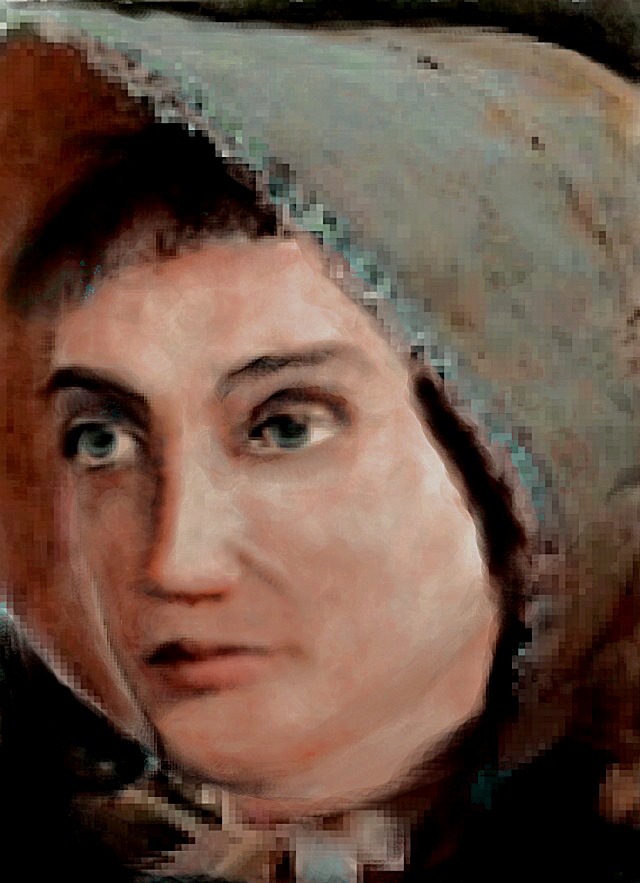ABRAHAM LINCOLN'S PARENTS
|
|
NANCY HANKS LINCOLN, birth mother of Abraham Lincoln, was born on February 5, 1784, in Hampshire County, (West) Virginia. The birth occurred in a cabin along Mike's Run at the foot of New Creek Mountain in what is now Mineral County, West Virginia.
Noted historian Louis Warren, an expert on Abraham Lincoln, stated in his writings that Nancy's mother was Lucinda Lucy Shipley Hanks, daughter of Robert Shipley, Jr., but nothing is really known for certain about Nancy's father. However, he was said to be James Hanks, son of Joseph Hanks. According to Louis Warren, James Hanks passed away in 1785. Lucinda Shipley Hanks was often confused by biographers with Lucy Hanks, the daughter of Joseph Hanks, but they were two different people.
According to Abraham Lincoln's law partner, William Herndon, Abraham once said that his maternal grandfather was "a well-bred Virginia farmer or planter." During the same conversation, Abraham said of his mother, "God bless my mother; all that I am or ever hope to be I owe to her." (It should be noted that this statement has never been verified other than having Herndon’s word for it.)
Little is known of Nancy's early life. As a child Nancy was taken by her mother along the Wilderness Road through the Cumberland Gap into Kentucky. Young Nancy went to live with Lucy’s sister, Rachel Shipley Berry, and her husband Richard Berry, Jr., in Beechland, Kentucky, in Washington County. She lived with the Berrys until she married Thomas Lincoln. Why she didn’t go to live with her mother after Lucy remarried is not known.
As Nancy grew up, she became skilled in the art of needlework, and she became an excellent seamstress. She was hired to sew anything from wedding gowns to funeral attire. Nancy became known for her work ethic, neatness, cheerfulness, and intelligence. She was deeply religious. Her cousin, John Hanks, described Nancy as having dark hair, hazel eyes, 5-7 in height, a delicate frame, weighing 120 pounds, and "was loved and revered by all who knew her." No photographs of Nancy exist.
Nancy sometimes lived briefly with families she was sewing for; her services were in demand in Hardin, Mercer, and Washington counties. During the time Nancy was working as a seamstress she met Thomas Lincoln, a carpenter from Elizabethtown. A romance developed, and the two decided to be married.
On June 12, 1806, Nancy Hanks and Thomas Lincoln were married; presiding over the ceremony was the Reverend Jesse Head. The couple moved to a cabin in Elizabethtown where Thomas worked as a carpenter making cabinets, door frames, even coffins. The Lincolns joined the Little Mount Separate Baptist Church. A daughter, Sarah, was born to the couple on February 10, 1807.
Later the Lincolns moved to the Sinking Spring Farm on Nolin Creek about three miles from Hodgenville. There, on the morning of Sunday, February 12, 1809, Nancy gave birth to a boy. He was born on a bed of poles covered with corn husks. Peggy Walters, a neighbor who was only 20 years old, assisted with the birth and said "Nancy had about as hard a time as most women, I reckon, easier than some and maybe harder than a few. It came along kind of slow, but everything was regular and all right. The baby was born just about sunup on Sunday morning." The boy was named Abraham after his paternal grandfather who had been killed by a Native American in 1786.
In 1811 the Lincolns moved to another cabin on Knob Creek. Soon, Nancy had another boy, Thomas, who died in infancy. Nancy cried as Dr. Daniel B. Potter, an Elizabethtown physician, tried in vain to save little Tommy.

Original oil painting of Nancy Hanks by Lloyd Ostendorf. Mr. Ostendorf was a famous author, artist, and collector of Lincolniana. The painting in not in the public domain; copyright 1963 by Lloyd Ostendorf, used with permission.
In the autumn of 1816 the Lincolns moved to southern Indiana. They settled in the wilderness on Little Pigeon Creek in Perry (later Spencer) County. Not long thereafter, Nancy's aunt and uncle, Thomas and Elizabeth Sparrow, moved and (after living in the Lincolns' cabin for awhile) built their own cabin on a nearby lot.
Nancy was a good and loving mother to her children. She was very ambitious for them and hoped they could have the opportunities in life that she and Thomas had missed. She read to Sarah and Abraham from the Lincoln family Bible.
In 1818 an attack of milk sickness struck the Little Pigeon Creek community. This is a disease contracted by drinking milk from cows which have grazed on poisonous white snakeroot. Both of the Sparrows died, and Thomas Lincoln made the coffins for them. Nancy took ill also. For a week she struggled, but she knew she was failing. Dennis Hanks, Nancy's cousin, recalled that she called the children to her bedside and asked them to be good and kind to their father, to each other, and to the world. On October 5, 1818, Nancy Hanks Lincoln passed away at the age of 34. In later years, Abraham would recall helping to carve pegs for his mother's coffin. Thomas Lincoln hauled the coffin, which was made of green pine, on a sled to the top of a thickly wooded hill and buried Nancy without a formal funeral service. Several months later, the Reverend David Elkins preached a funeral sermon above Nancy's grave.

THE FUNERAL OF NANCY HANKS LINCOLN
Source: Page 60 of The Every-Day Life of Abraham Lincoln by Francis Fisher Browne
The grave of Nancy Hanks Lincoln is located within the Lincoln Boyhood National Memorial in Lincoln City, Indiana. If you are interested in Hanks' genealogy, please Click Here.
|
Poet Rosemary Benet wrote the following poem entitled "Nancy Hanks"
|
If Nancy Hanks
Came back as a ghost,
Seeking news
Of what she loved most,
She'd ask first
"Where's my son?
What's happened to Abe?
What's he done?"
"Poor little Abe,
Left all alone
Except for Tom,
Who's a rolling stone;
He was only nine
The year I died.
I remember still
How hard he cried." "Scraping along
In a little shack,
With hardly a shirt
To cover his back,
And a prairie wind
To blow him down,
Or pinching times
If he went to town." "You wouldn't know
About my son?
Did he grow tall?
Did he have fun?
Did he learn to read?
Did he get to town?
Do you know his name?
Did he get on?"
|
|
Julius Silberger wrote "A Reply to Nancy Hanks" |
Yes, Nancy Hanks,
The news we will tell
Of your Abe
Whom you loved so well.
You asked first,
"Where's my son?"
He lives in the heart
Of everyone. |
|
|
THOMAS LINCOLN, Abraham Lincoln's father, was born January 6, 1778, to Bathsheba and Abraham Lincoln. Thomas, who was born in Rockingham County, Virginia, was the fourth of five children born to the couple. His older siblings were Mordecai, Josiah, and Mary. Thomas had a younger sister named Nancy. During the early 1780's the family moved to Jefferson County in Kentucky. Native Americans killed Thomas’ father, Abraham, in an attack in May 1786. In 1795 Thomas was listed by name in the Washington County tax lists as a white male between the ages of 16 and 21. In c. 1797 Thomas spent a year working as a hired hand for his Uncle Isaac on the Watauga River in Tennessee.
Thomas moved to Hardin County, Kentucky, in 1802, and he purchased a 238-acre farm the next year. In 1806 he married Nancy Hanks. The couple had three children: Sarah, Abraham, and Thomas (who died in infancy).
Thomas was a farmer and a carpenter and was a responsible citizen living on the frontier. He was at times a jury member, a petitioner for a road, and a guard for county prisoners. In terms of education he lacked ambition, and he never fully understood Abraham's desire to read and learn. He was a good storyteller and was popular with his neighbors. Thomas and Nancy were members of the Little Mount Separate Baptist Church which had broken from the regular church over the issue of slavery.
Thomas stood approximately 5-9 or 5-10 and weighed about 190 pounds. His face was well rounded. He had dark hazel eyes and course black hair. Thomas was compactly built and very strong physically. He was temperate in his drinking habits and generally had an inoffensive personality. Late in 1816 Thomas moved his family to southern Indiana. A homesite was chosen 16 miles north of the Ohio River about a mile from Little Pigeon Creek. By February 1817 Thomas had built a new log cabin 18 feet square with a packed dirt floor and a stone fireplace used for both cooking and heating. Although Abraham was only eight, he was handed an ax and put to work helping to clear fields, chop wood, and split rails for fences. Sadly, in 1818 Nancy Hanks Lincoln passed away from milk sickness at the age of 34.

The next year Thomas went back to Elizabethtown, Kentucky, and proposed to Sarah Bush Johnston, a widow whom he had known for many years. On December 2, 1819, the two were married. Soon the couple traveled back to the cabin in Indiana along with Sarah's three children by a previous marriage: Elizabeth (13), Matilda (10), and John D. (9). In 1823 Thomas joined the Little Pigeon Baptist Church.
By 1827 Thomas was the owner of 100 acres of land, and in 1829 began building a better cabin. He received news from John Hanks that Illinois had fertile soil and was free of the milk sickness that had killed his first wife. Thomas never finished his new cabin; he decided to move again - this time to Illinois.
|
Thomas sold his Indiana property and moved to Macon County, Illinois, in 1830. In 1831 he moved to Coles County which was also in Illinois. It was here that he lived for the rest of his life.
He lived on three farms in Coles County, and he purchased his last one - the Goosenest Prairie farm - in 1840 (reproduction pictured to the right).
The Goosenest Prairie home was a double-room style cabin which was essentially two log cabins built close to each other with the space between boarded over. By 1845 18 people were living in the structure. These included Thomas and Sarah, Sarah's son, John, and his wife, Mary, and their six children; Sarah's daughter, Matilda, her husband, Squire Hall, and their six children.
As a farmer Thomas raised corn, oats, and wheat. His livestock included chickens, horses, hogs, milk cows, sheep, and geese. By 1841 Thomas owned 120 acres of land but eventually sold a third of his land to Abraham (now a successful lawyer in Springfield) to get out of financial difficulty. In 1848 he received $20 from Abraham to save the rest of the land from forced sale.
|
|
|
Thomas Lincoln passed away on January 17, 1851, at the age of 73. Abraham, who was not close to his father, did not attend the funeral. Thomas is buried with his second wife, Sarah Bush Johnston Lincoln, in Shiloh Cemetery located one mile west of the Lincoln Log Cabin State Historic Site between Charleston and Lerna, Illinois. |
|
SARAH BUSH JOHNSTON LINCOLN, Abraham Lincoln's stepmother, was born in Hardin County, Kentucky, on December 13, 1788. She was one of three daughters of Christopher and Hanna Bush. The Bush family consisted of nine children. The male children were William, Samuel, Isaac, Elijah, Christopher and John. The female children were Hannah, Rachel, and Sarah. By the time Sarah was two, the family had moved to the Elizabethtown area and Sarah grew up there. Sarah met young Thomas Lincoln in Elizabethtown, but she married a man named Daniel Johnston on March 13, 1806. Rev. Benjamin Ogden, a Methodist preacher, performed the ceremony. Little is known about Daniel Johnston other than the fact that he was always in debt. On November 14, 1814, Johnston was appointed as jailer of Hardin County. Living quarters for the jailer and his family were provided in one corner of the stone jail. Sarah cooked for the inmates and kept the jail clean. Most likely this was an unhappy environment for Sarah and the three young children the Johnstons had (Elizabeth, Matilda, and John D.).
In the summer of 1816 Daniel Johnston died. Sarah then moved into a cabin owned by Samuel Haycraft. Later she purchased the cabin and was living there with her three children when, late in 1819, Thomas Lincoln appeared at her door announcing that he had been a widower for more than a year. Thomas learned that Sarah owed a few debts, and after Thomas paid these, the two were married. The wedding took place on December 2, 1819. This was the second marriage for both Thomas (age 41) and Sarah (age 31).
All of Sarah's belongings were piled into a wagon, and the group headed for Thomas' home in Indiana. Thomas rode on horseback, and Sarah and her three children rode in the crowded wagon. When they finally arrived, Abraham and Sarah Lincoln met their new mother and found they would have three new playmates.
It seems young Abraham took to his new mother right away. Among her belongings were several books including Webster's Speller and Robinson Crusoe. Sarah provided a refreshing new home life for both Lincoln children. Although Sarah was illiterate herself, she seems to have greatly encouraged Abraham's studious habits. She told William Herndon that "Abe was the best boy I ever saw" and that he "never gave me a cross word or look." Additionally she tried to persuade Thomas Lincoln to look more kindly on Abraham's reading habits. Her influence on Abraham was excellent, and the two grew to love each other.
In appearance Sarah stood straight and tall and had black, curly hair. She was a hard worker who was charitable and kind-hearted. Those who knew her noted her strong moral character. The Lincoln family remained in Indiana until 1830 when they moved on to Illinois, finally settling in present day Coles County, Illinois.
When Abraham went off on his own in 1831, he continued to visit his stepmother periodically. When Thomas Lincoln died in 1851, Abraham retained a 40-acre plot of land in his own name "for Mother while she lives." All of Sarah's children were married and each had at least seven children. By the 1850's Sarah was a grandmother to over 20 children. She remained an energetic person, but she occasionally suffered from rheumatism.
After Abraham was elected president in 1860, he made one last visit to his stepmother before he left for Washington. During this visit Abraham and Sarah rode out to Shiloh Cemetery to visit the grave of Thomas Lincoln. It seems that Sarah had a premonition that this would be the last time she would see her beloved stepson.
Sarah continued to live at the Goosenest Prairie home for her remaining years. She passed away at the age of 80 on April 12, 1869. (Source: "Sarah Bush Johnston Lincoln's Date of Death" by Wayne C. Temple in the Fall 2000 edition of the Lincoln Herald.) She is buried with her second husband, Thomas Lincoln, in Shiloh Cemetery located one mile west of the Lincoln Log Cabin State Historic Site between Charleston and Lerna, Illinois.
|
|
Some sources of information on Abraham Lincoln's parents include The Abraham Lincoln Encyclopedia by Mark E. Neely, Jr., In Lincoln's Footsteps by Don Davenport, The Lineage of Lincoln by William E. Barton, The Paternity of Abraham Lincoln by William E. Barton, The Women Lincoln Loved by William E. Barton, Herndon's Life of Lincoln by William H. Herndon and Jesse W. Weik, Lincoln's Boyhood Indiana Years 1816-1830 by Louis A. Warren, and Lincoln's Boyhood by Francis Marion Van Natter. For younger readers there are Nancy Hanks of Wilderness Road: A Story of Abraham Lincoln's Mother by Meridel Le Sueur and Abe Lincoln's Other Mother: The Story of Sarah Bush Lincoln by Bernadine Bailey. Additionally there is Lincoln's
Mothers: A Story of Nancy and Sally Lincoln by Dorothy Clarke Wilson.
The photograph of Thomas Lincoln is from the Lincoln Memorial University in Harrogate, Tennessee. The photograph of Sarah Bush Johnston Lincoln is from the Illinois State Historical Library.
  The gravestones of Abraham Lincoln's paternal grandparents (Credit: Joe Di Cola)
The gravestones of Abraham Lincoln's paternal grandparents (Credit: Joe Di Cola)
NOTE: The authenticity of the photograph of Thomas Lincoln has not been established with absolute certainty. For a discussion of this issue, please see Michael Lynch's article entitled "Putting a Face to the Name: Another Look at the Thomas Lincoln Photo" in the Winter 2008 edition of the Lincoln Herald.
An online public library with over 100 books named in honor of Nancy Hanks Lincoln and a copy of the original edition of Nancy Hanks Lincoln: A Frontier Portrait is available for free download on PDF made from a scan, and not doctored. It can be found under the American Politics tab located within the main books tab. CLICK HERE to go to the library.
I would like to say thank you to Gary Brin for his help with certain particulars on this page.
|
|









